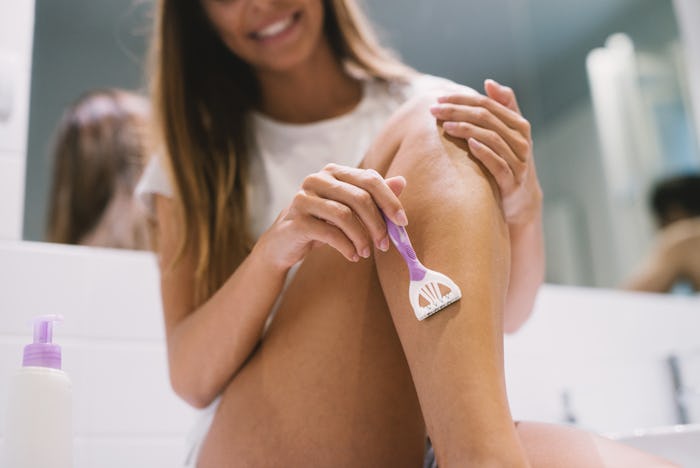Shaving is a routine chore for most people. Even with the availability of waxing or laser hair removal, many people still stick with a good old razor blade for fast, easy hair removal. So to make the most of your razor, these shaving tricks from a dermatologist will change your routine forever. Hey, nobody enjoys dealing with razor burn.
To learn more about the world of safe shaving, Romper spoke with Dr. Edidiong Kaminska, a Board Certified Dermatologist and Fellow of the American Academy of Dermatology. She knows all about skin and the ways to protect it from harm. And and she explained, improper shaving can result in worse health concerns than a few nicks and cuts. Ingrown hairs and folliculitis are potential problems.
Most everyone has had the misfortune of encountering an ingrown hair here and there. "Ingrown hairs occur when the hair grows out of the skin and then turns back inwards into the skin," said Dr. Kaminska. "The body recognizes the hair as foreign and can cause bumpy skin that can be associated with inflammation and irritation." They can be annoying and downright painful, and once you get one, you never want to deal with them again.
On the other hand, folliculitis is a more serious concern that can result from improper shaving. "Folliculitis is a skin condition in which hair follicles become inflamed. This is commonly caused by a bacterial infection," said Dr. Kaminska. "Usually a patient will noticed small pus-bumps or white pimples around a hair follicle." Because you definitely don't want to get a skin infection from your razor blade of all things, read on to discover the best and safest ways to shave.
1Shave Gel
Shaving gel isn't just an extra, unnecessary step. It's an important part of the process. "Proper moisturization is an important first step because soft hair is easier to cut than dry hair," said Dr. Kaminska.
2Sharp Blade
Sure, it's tempting to use that blade once it's a bit dull, because those razor cartridges can get stupid expensive. But Dr. Kaminska recommends using a sharp blade for the closest, most comfortable shave.
3Clean Blade
How often do you clean your razor blade? Its sanitization can make a difference. "To prevent infection, I recommend patients clean razors at least once weekly with rubbing alcohol," said Dr. Kaminska.
4Against The Grain
Shaving against the hair grain will achieve the closest shave, but it may increase the risk of complications, as Dr. Kaminska explained. For very sensitive skin, you may want to shave with the grain.
5Don't Dry Shave
Hey, we've all been there. Sometimes a last-minute change of plans leaves you trying to shave your legs without any cream (or even water). But Dr. Kaminska understandably recommends against dry shaving, which can irritate your skin. Plus, the sound of a dry razor scraping against skin is terrible.
6Skip The Scents
In addition, Dr. Kaminska recommends a moisturizing, foaming shave gel that's also fragrance free. This will help you get a close shave without risking much skin irritation.
7Stop If Skin Irritation Occurs
Don't power through the pain if your razor is causing skin damage. Stop shaving if you develop a skin irritation or rash, as Dr. Kaminska recommended. If the skin irritation gets too concerning, don't hesitate to reach out to your dermatologist for advice. Shaving may be a chore, but it should never cause serious pain or skin issues.
